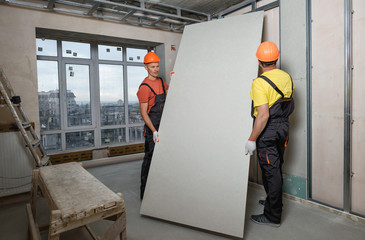Drywall installation at Jamaica Works is a great way to finish a room in your home or office. There are a few things to remember regarding this type of work. You need to consider the size and thickness of the material you use. You also want to look into the cost of the project. When you are putting together a budget for a home renovation, including the drywall installation cost. The best way to figure out exactly how much this project will cost you is to estimate the size of your room and how thick the drywall is.

Drywall is a great solution for any home. It is highly recyclable, energy-efficient, and can last 30 to 75 years with proper care. However, the price can quickly add up. For instance, installing sheetrock can cost between $0.24 and $25 per square foot. This number can change depending on the thickness, which can make it difficult to budget.
The cost will be higher for a drywall installation that’s not done by a professional. There is also more work to do. To get started, your contractor must prepare the area, install the drywall, and cleanup.
The thickness of drywall is an important decision since the wrong thickness can cause problems with your home improvement project. Fortunately, there are several drywall thickness options available, so you should be able to find something that will fit your needs.
The most common drywall thickness is half an inch, but other options exist. Each has its own benefits and applications. For example, 5/8 inch drywall is thicker and heavier than other types, but it’s great for soundproofing.
Another option is 3/8-inch drywall, which is a bit thinner and more flexible than 1/2-inch panels. It’s ideal for skimming over existing plaster or walls and for covering up blemishes. The heaviest drywall is 5/8-inch, and this is used for ceilings and walls. It can also be used with wood frames and steel studs.
Choosing the right sizes for drywall installation is important, especially if you’re building a home. It can be confusing to know what’s available and how to figure out which one is right for you. To make your job easier, here’s a guide to the different sizes and thicknesses.
Aside from the obvious sizing requirements, there are other factors to consider. For instance, do you need to hang drywall over wooden studs or steel? If so, you’ll need drywall screws to get the job done.
Another issue to consider is the weight of drywall. Thicker drywall panels are typically more durable and will offer better moisture resistance and fire retardance. However, they are also heavier, so you may want to opt for the lighter variety.
Whether you’re constructing a new home or renovating an older one, you may wonder if you should use drywall or plaster to complete the project. Both are popular options for interior walls, but there are a few key differences between the two that you should know.
For starters, drywall is less expensive than plaster. It’s also much simpler to install. This is especially true if you are working on your own. However, hiring a professional to complete the job can be cost-effective.
Drywall has electrical outlets and can be cut to fit doorways and windows. In addition, drywall is easier to maintain. This means you can keep your home looking its best longer.
While drywall is a more durable option, plaster is smoother. If you’re trying to hang a picture, it’s important to choose a material that will not crack or splinter. Another advantage of drywall is that it can be easily textured. You can put a smooth coat of paint on the surface or combine it with wallpaper.
Finishing drywall is the final step in any project. This process aims to make the wall surface smooth and uniform. To get the best results, it is important to understand how to prepare the drywall for painting. First, a clean room is needed. Doors, windows, and furniture in the workspace should be covered to prevent dust from entering. Safety goggles should also be worn to prevent any dust from getting into the eyes.
Secondly, mark the location of the joists and other framing components with chalk lines. These marks should be at least a quarter of an inch away from the wall. If your walls have curved arches, use a quarter-inch sheet of drywall. Next, place the first drywall board flush against the top corner of the wall. Secure the drywall with five evenly spaced screws.